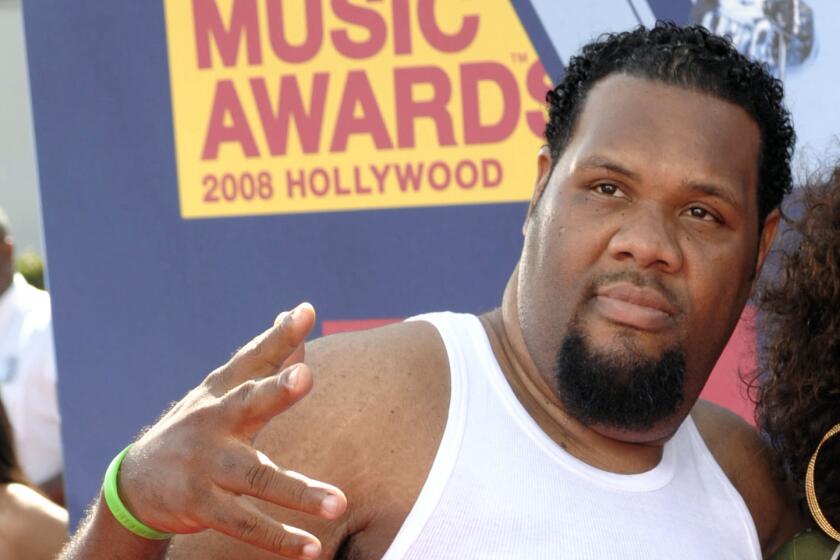Networks Have an Ear for Spanish
In ABC’s new sitcom “Freddie,” one of the main characters -- Freddie Prinze Jr.’s Puerto Rican grandmother -- speaks only Spanish. The show, which premieres in October, will use subtitles to translate her words.
In “Go, Diego, Go!,” a Nickelodeon cartoon that premiered last week, the hero is a brown-skinned bilingual boy who lives in a rain forest and teaches viewers to say “cuidado” (be careful) and “al rescate” (to the rescue).
And to lend authenticity to UPN’s upcoming prime-time soap, “South Beach,” some scenes are being shot entirely en espanol. Subtitles will be sprinkled throughout the midseason offering, which Jennifer Lopez’s production company is shooting on location in Miami.
Not so long ago, the only Spanish that most people heard on television came during reruns of “I Love Lucy,” when Ricky Ricardo went on a tear.
But as Latinos become the largest minority group in the U.S., representing an estimated $700 billion a year in buying power, media companies and advertisers are scrambling to figure out how to appeal to them.
“There’s a huge change in the economics of television,” said Bruce Helford, a creator and executive producer of “Freddie” and the 3-year-old sitcom “George Lopez” on ABC. “Now, there is an honest push to have shows reflect the culture and complexion of the audience who’s watching.”
Just last month, TV ratings giant Nielsen Media Research increased its estimate of the number of Latino homes with televisions in the U.S. to 11.2 million. That means Nielsen will be recruiting more Latinos for its audience surveys, which could boost ratings for programs popular among Latinos and allow networks to charge more to run ads during those shows.
“The Hispanic market is growing in affluence, and it’s growing in influence,” said Felipe Herrera, director of diversity sales and marketing for General Motors, one of the nation’s largest buyers of TV advertising. “We recognize that this is an incredible opportunity.”
Spanish-language networks such as Univision Communications Inc. have a track record not just of reaching this audience but often owning it.
But now, with shows such as “Freddie,” some executives at the major networks are experimenting with a mix of English and Spanish to win over what some say is becoming one of the most attractive groups of all: young bilingual Latinos.
“ ‘Freddie’ is on to something,” said Stephen Chavez, a vice president of the Los Angeles-based Latino advertising agency La Agencia de Orci. “Second- and third-generation Latinos like myself want to see characters who reflect their lifestyle and their culture. And story lines that are relevant to our lives.”
Latinos now make up the nation’s fastest-growing consumer market. In addition, people under the age of 18 make up more than 34% of Latinos, compared with 25% of the overall U.S. population, according to Hispanic Business’ research arm, HispanTelligence.
A more significant demographic shift is also underway. For three decades, immigrants -- who traditionally speak primarily Spanish -- have made up the largest population of Latinos in the U.S. But now, Latino births are outpacing the arrival of new immigrants.
“In 15 years, the number of second- and third-generation Hispanics will outnumber the foreign-born population,” said Antoinette Zel, senior executive vice president for network strategy for NBC Universal’s Spanish-language network, Telemundo. “That is clearly the coveted demographic. Ad agencies are calling and saying: ‘Give us new ways to talk to this generation.’ ”
TV executives and advertisers admit that they are struggling with how best to reach this group. There is disagreement over whether bilingual Latinos prefer to watch programs in English or in Spanish.
“That is the billion-dollar question,” said Gary Bassell, chief executive of the Bravo Group, a New York advertising agency that specializes in reaching Latinos.
“It’s sort of the Rubik’s Cube of the business.”
One reason for the confusion is the continued dominance of Univision. This summer, the Spanish-language network’s ratings have soared nearly 30% among young adults.
During three straight weeks in August, for example, nine of the top 10 prime-time shows airing in Los Angeles were the network’s Spanish-language telenovelas, or soap operas.
No wonder Univision is not budging from its strategy of airing Spanish-language shows.
“At the end of the day, almost everyone prefers to come home to speak Spanish and watch Spanish-language programming,” said David Woolfson, Univision senior vice president for network research.
Others aren’t so sure and are hedging their bets. Telemundo, for example, has more than doubled its budget for bilingual programming for its youth-oriented cable channel “mun2” -- a play on the words mundo, which means “world,” and dos, or “two.” Next month it will begin overhauling its programming to appeal to more bilingual Latinos.
Jeff Valdez is going even further. Last year, after working six years to raise $60 million in financing, Valdez launched Si TV, an English-language cable channel targeting Latinos.
“A lot of people would say, ‘That’s an interesting niche.’ But this is not a niche -- this is the general market,” he said.
Valdez said that even in the last year, he has seen a shift in the way advertisers are trying to reach young Latinos. When Si TV launched, some advertisers provided Spanish-language ads even though the channel’s programming is English.
“That’s all they had,” Valdez said. “But we’re seeing less of that. Everybody is now getting on the bandwagon.”
Advertisers recognize that young Latinos are big consumers of wireless phones, music downloads and other entertainment. According to the Motion Picture Assn. of America, Latinos go to the cinema more than any other group; 45% of Latinos see at least one movie a month in a theater.
“This is a market we cannot ignore,” said Viviana Pendrill, vice president for targeted marketing for Warner Bros. Pictures, a major TV advertiser.
To extend what she called “a personal invitation” to these loyal moviegoers, she said, Warner Bros. has created commercials that give “a wink and a nod” to bilinguals. For example, an English-language ad might feature a Spanish-language song.
General Motors’ Herrera agreed that marketers and programmers need to speak more effectively to bilingual Latinos by “not only knowing the language but also the heritage, the culture and the lifestyle.”
Nickelodeon, Viacom Inc.’s children’s cable channel, is considered a pioneer in this kind of nuanced programming.
In 1998, when a Nickelodeon executive named Brown Johnson attended a conference on children’s issues in Los Angeles, she was struck by a recurring complaint: the lack of Latino role models on TV.
When she returned to New York, Johnson -- now executive creative director for Nickelodeon preschool television -- decided to do something. She suggested that a proposed animated series about a bunny be recast to revolve around a Latina girl.
“Dora the Explorer” was born. She had brown eyes -- changed from green, Johnson said, “because that was more representative of Latinos.” Dora was also bilingual.
When teaching Spanish expressions such as “lo hicimos!” (we did it!), Dora would pause a moment to give children at home time to shout out the words.
“The idea is that being able to speak a second language becomes a magical power,” Johnson said, noting that some Latino youngsters can feel stigmatized by having to translate for their parents. “We wanted to make it special as opposed to being embarrassed about it.”
The show, which first aired in August 2000, quickly became one of the most popular programs among preschoolers. Last May, about 8.8 million children tuned in each morning. More than $3 billion of Dora merchandise has been sold since 2001.
“Dora is now going mano a mano with SpongeBob, and you know how big he is,” said Herb Scannell, vice chairman of Nickelodeon’s parent division, MTV Networks.
With this week’s launch of “Go, Diego, Go!”, which centers on Dora’s 10-year-old cousin, Scannell said Nickelodeon was continuing to “put Latin culture front and center.”
The major networks have been much slower to adapt.
Four years ago, there were no prime-time network programs with predominantly Latino casts. The odds where long when ABC put “George Lopez” on the air in early 2002.
“Imagine going in knowing that no Mexican American before you had ever succeeded in a lead role,” said Lopez. He wanted his comedy to portray an American family -- much like the Huxtables on NBC’s landmark “The Cosby Show” -- who just happened to have Mexican roots.
“I wanted my character to be accessible and nonthreatening,” Lopez said in an interview. So for nearly two seasons, Lopez avoided using any Spanish phrases (though from the get-go, ABC made a dubbed version of the show for Spanish-speakers).
But that changed as network executives and advertisers began to embrace Latino culture and as viewers warmed to “George Lopez.” Last season, for example, Lopez’s character made a deal with God that if the family dog recovered from an illness, Lopez would travel south of the border to give thanks at a famous church. The show ended with Lopez in Mexico.
Next week , ABC will go a step further, becoming the first English-language broadcast network to provide all prime-time entertainment programming in Spanish. In addition to “George Lopez,” “Freddie” and the hit shows “Desperate Housewives” and “Lost” will be available dubbed in Spanish. The rest of the lineup will have subtitles.
“We wanted to move beyond toe-dipping and really dive in,” said Stephen McPherson, president of ABC Entertainment.
UPN executives are hoping “South Beach” will also strike some cultural chords. The show, about two young working-class guys from Brooklyn who head to South Florida to start new lives, plans to put Miami’s “mash-up” ethnic mix on full display.
“Miami is this fascinating fusion of Afro-Caribbean, Latin, European and American cultures,” said writer and executive producer Philip Levens. “We want that flavor.”
“Freddie,” meanwhile, is a far cry from “Chico and the Man” -- the 1970s sitcom starring Prinze’s late father as a worker in an auto mechanic’s shop who slept in a beat-up truck. In “Freddie,” Prinze plays a successful chef who lives in a spacious Chicago loft.
Instead of tangling with an old grumpy white boss, as his father did, Prinze interacts primarily with four female relatives. The show is full of Latin cultural references, including an “evil eater” icon nailed over the door to chase away bad spirits.
Bassell of the Bravo Group predicts that if handled deftly, such themes could appeal not just to Latinos, but to young people of all ethnicities “who’ve been shaped by an American pop culture today that increasingly proves that color is cool and white is washed out.”
More to Read
The biggest entertainment stories
Get our big stories about Hollywood, film, television, music, arts, culture and more right in your inbox as soon as they publish.
You may occasionally receive promotional content from the Los Angeles Times.











